Digital Posters
Spectroscopy: Neuro I
ISMRM & SMRT Annual Meeting • 15-20 May 2021

| Concurrent 2 | 17:00 - 18:00 |
2199.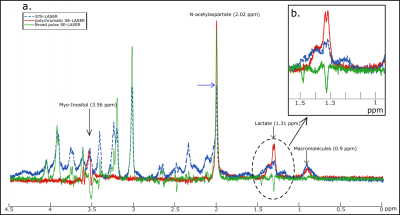 |
Evaluation of a spectroscopy sequence using polychromatic refocusing to suppress J-modulation and measure lactate diffusion in the rodent brain
Sophie Malaquin1, Eloïse Mougel1, Melissa Vincent1, and Julien Valette1
1Université Paris-Saclay, Commissariat à l'Energie Atomique et aux Energies Alternatives (CEA), Centre National de la Recherche Scientifique (CNRS), Molecular Imaging Research Center (MIRCen), Laboratoire des Maladies Neurodégénératives, Fontenay aux Roses, France
Diffusion-weighted NMR spectroscopy allows non-invasive measurement of the diffusion properties of brain metabolites. Lactate is of particular interest but has low concentration thus requiring the development of new sequences to maximize signal-to-noise ratio. In this work, we compare a reference stimulated echo sequence and two spin echo sequences using either a broad pulse, or a selective polychromatic pulse suppressing J-modulation, by measuring the signal attenuation as a function of diffusion-weighting. Suppression of J-modulation with the polychromatic spin echo sequence leads to a significant signal gain and a better precision in lactate signal attenuation.
|
|||
2200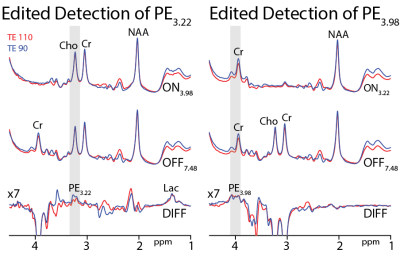 |
In Vivo J-difference Editing of (Phosphoryl)ethanolamine Video Permission Withheld
Muhammad G Saleh1, Steve Hui2, Helge Zöllner2, and Richard A Edden2
1University of Maryland School of Medicine, Baltimore, MD, United States, 2The Johns Hopkins University School of Medicine, Baltimore, MD, United States
Phosphorylethanolamine/ethanolamine (PE) serves as an important precursor for choline-containing compounds that are crucial for cell-membrane formation and maintenance. As such, PE can be influenced by pathways involving choline production in brain diseases that cause neuroinflammation. PE is also implicated in diseases that are known to cause neuronal damage. Therefore, PE may be a potential marker for investigating brain integrity. MEGA-PRESS, a spectral editing method, allows direct detection and in vivo measurement of PE. Here, we demonstrate the optimal editing of PE using MEGA-PRESS to facilitate unambiguous in vivo measurements of PE.
|
|||
2201.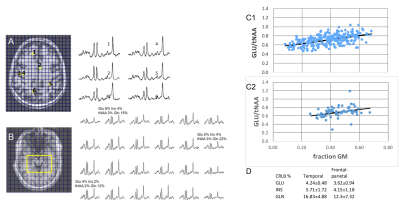 |
Spectral quality of J-refocused spectroscopic imaging at 7T
Jullie W Pan1, Victor W Yushmanov2, Chan H Moon3, Brian Soher4, Frank H Lieberman5, and Hoby P Hetherington2
1Radiology, University of Pittsburgh, Pittsburgh, PA, United States, 2university of pittsburgh, pittsburgh, PA, United States, 3University of Pittsburgh, Pittsburgh, PA, United States, 4Radiiology, Duke University, Durham, NC, United States, 5Neurology, University of Pittsburgh, Pittsburgh, PA, United States
The J-refocused double spin echo sequence is applied at 7T using the 8x2 transceiver and demonstrated in the frontal-parietal and temporal lobe regions. Spectral quality parameters based on the Cramer Rao lower bound, linewidth and SNR are calculated and considered for multiplet and singlet compounds, finding that the variance in highly overlapped compounds such as myo-Inositol are more steeply dependent on spectral uncertainty compared with singlet compounds. With fast encoding methods, the J-refocused acquisition is achieved in clinically acceptable imaging times (<3min, single slice) and can detect abnormalities in Glutamine in brain tumor patients.
|
|||
2202.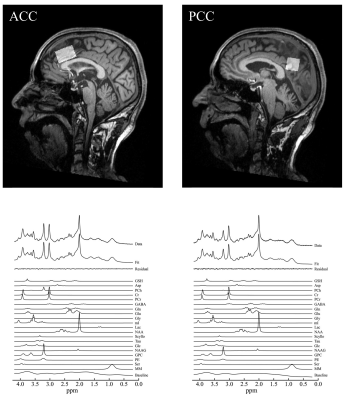 |
Associations of tau aggregates and oxidative stress to apathy levels in progressive supranuclear palsy
Kiwamu Matsuoka1,2, Yuhei Takado1, Kenji Tagai1, Manabu Kubota3, Yasunori Sano1, Keisuke Takahata1, Maiko Ono1, Chie Seki1, Hideki Matsumoto1,4, Hironobu Endo1, Hitoshi Shinotoh1, Jamie Near5, Kazunori Kawamura1, Ming-Rong
Zhang1, Hitoshi Shimada1, and Makoto Higuchi1
1National Institute of Radiological Sciences, National Institutes for Quantum and Radiological Science and Technology, Chiba, Japan, 2Department of Psychiatry, Nara Medical University, Kashihara, Japan, 3Department of Psychiatry, Kyoto University Graduate School of Medicine, Kyoto, Japan, 4Department of Oral and Maxillofacial Radiology, Tokyo Dental College, the city of Chiyoda-ku, Japan, 5Douglas Mental Health University Institute and Department of Psychiatry, McGill University, Montréal, QC, Canada
Apathy is characterized by lack of motivation. We investigated the mechanisms underlying apathy in progressive supranuclear palsy (PSP), which is characterized by tau aggregate accumulations causing oxidative stress in the brain. Using magnetic resonance spectroscopy and tau positron emission tomography, we found associations of apathy levels with glutathione levels in the posterior cingulate cortex (PCC), tau aggregate accumulation levels in the angular gyrus/PCC, and atrophy of the right inferior frontal gyrus and anterior cingulate cortex. The vulnerability of the anterior and posterior brain regions where apathy is related is suggested as possible underlying mechanisms for apathy in PSP.
|
|||
2203.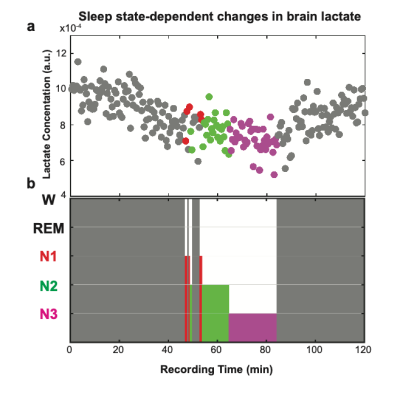 |
Sleep-Wake Lactate Dynamics in Human Brain
Selda Yildiz1,2, Miranda M. Lim2,3,4,5,6, Manoj K. Sammi1,7, Katherine Powers1, Charles F. Murchison2,8, Jeffrey J. Iliff9,10,11,12,13, and William D. Rooney1,2,5,10
1Advanced Imaging Research Center, Oregon Health & Science University, Portland, OR, United States, 2Department of Neurology, Oregon Health & Science University, Portland, OR, United States, 3VA Portland Health Care System, Portland, OR, United States, 4Department of Medicine, Division of Pulmonary and Critical Care Medicine, Oregon Health & Science University, Portland, OR, United States, 5Department of Behavioral Neuroscience, Oregon Health & Science University, Portland, OR, United States, 6Oregon Institute of Occupational Health Sciences;, Oregon Health & Science University, Portland, OR, United States, 7BENFRA Botanical Dietary Supplements Research Center, Oregon Health & Science University, Portland, OR, United States, 8Department of Biostatistics, University of Alabama, Birmingham, AL, United States, 9Department of Anesthesiology and Perioperative Medicine, Oregon Health & Science University, Portland, OR, United States, 10Knight Cardiovascular Institute, Oregon Health & Science University, Portland, OR, United States, 11VISN 20 Mental Illness Research, Education and Clinical Center (MIRECC), VA Puget Sound Health Care System, Seattle, WA, United States, 12Department of Psychiatry and Behavioral Sciences, University of Washington, Seattle, WA, United States, 13Department of Neurology, University of Washington, Seattle, WA, United States
This study describes a non-invasive combined magnetic resonance spectroscopy and polysomnography approach to measure brain metabolite levels together with simultaneous characterization of sleep or wake states. The results provide the first in-vivo demonstration of reductions in brain lactate concentration and diffusivity during sleep versus wakefulness in young healthy human brain. These findings are consistent with invasive small-animal studies showing the loss of extracellular lactate during sleep, and support the notion of altered lactate metabolism and/or increased glymphatic activity in sleeping human brain.
|
|||
2204. |
Reduced fMRI activation in the fusiform face area is related to higher hallucination proneness and lower glutamate levels assessed by 1H MRS
Ralf Mekle1, Jochen B. Fiebach1, and Heiner Stuke2
1Center for Stroke Research Berlin, Charité – Universitätsmedizin Berlin, Berlin, Germany, 2Department of Psychiatry and Psychotherapy, Charité – Universitätsmedizin Berlin, Berlin, Germany
The neurophysiological and neurochemical alterations involved in the formation of hallucinations are not sufficiently understood. fMRI was used during a face detection task, and neurotransmitter levels in the visual cortex were measured by 1H MRS at 3T to elucidate processes involved in the false (hallucinatory) detection of faces in pure noise patterns. Increased hallucinatory face detections were related to decreased activation of the fusiform face area. In addition, decreased face-dependent activation was related to reduced glutamate levels. These findings substantiate theories of hallucinatory misperceptions, which implicate impaired glutamatergic transmission in a reduced ability to differentiate between meaningful information and noise.
|
|||
2205.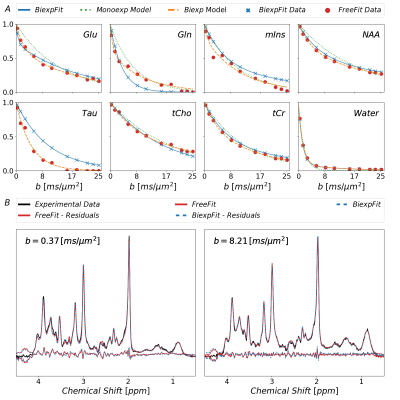 |
Simultaneous spectral and bi-exponential diffusion modeling of doubly motion-corrected human brain spectra with very high b-values
Kadir Şimşek1, André Döring1,2, André Pampel3, Harald E. Möller3, and Roland Kreis1
1Department of Radiology and Biomedical Research, University of Bern, Bern, Switzerland, 2Cardiff University Brain Research Imaging Centre (CUBRIC), School of Psychology, Cardiff University, Cardiff, United Kingdom, 3Max-Planck Institution for Human Cognitive and Brain Sciences, Leipzig, Germany
Diffusion-weighted MRS was successfully applied at short TE with ultra-high b-values on a 3T Siemens Connectom system. Additional motion compensation based on macromolecule signals was implemented to complement water-signal-based motion compensation, especially at high b-values. By extending simultaneous fitting of interrelated datasets to a biexponential diffusion model, non-Gaussian diffusion behavior of metabolites can be established in a more rigorous fashion. Finally, also the definition of macromolecular background signals by diffusion rather than relaxation properties benefits from these more robust methods and the patterns can now be used as bases for quantification in clinical studies at short-TE.
|
|||
2206. |
Rapid MRSI of the Brain on 7T Using Subspace-Based Processing
Fan Lam1,2, Hoby Hetherington3, and Jullie Pan3
1Bioengineering, University of Illinois Urbana-Champaign, Urbana, IL, United States, 2Beckman Institute for Advanced Science and Technology, University of Illinois Urbana-Champaign, Urbana, IL, United States, 3Radiology, University of Pittsburgh, Pittsburgh, PA, United States
We present here a new method for rapid MRSI of the brain on 7T that combines fast rosette trajectories and subspace-based processing from the SPICE MRSI framework. Results from in vivo experiments demonstrated substantial improvement in spectral quality and SNR achieved by the subspace imaging method over the standard reconstruction of rosette MRSI data. The ability to obtain single-slice rapid MRSI of the brain with an only 1.1 min acquisition was also demonstrated using the subspace-based reconstruction. These results highlight the potentials of integrating subspace imaging and fast acquisitions to push the performance of ultrahigh-field MRSI.
|
|||
2207.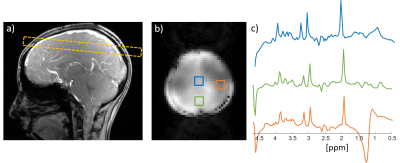 |
Echo-planar Spectroscopic Imaging with Readout-segmented COKE at 7T: Artifact Analysis using a Purpose-Built Phantom and Simulation
Graeme A. Keith1, Amir Seginer2, David A. Porter1, and Rita Schmidt3
1Institute of Neuroscience and Psychology, University of Glasgow, Glasgow, Scotland, 2Siemens Healthcare Ltd, Rosh Ha’ayin, Israel, 3Neurobiology Department, Weizmann Institute of Science, Rehovot, Israel
Echo-planar spectroscopic imaging (EPSI) is a fast method of acquiring metabolic information in the human brain. When applied at high-fields, such as 7T however, it suffers from limited spectral-width, as well as the inconsistencies between readout lines, seen at all field strengths, which lead to ghosts in the spectra. In this work, we present the readout-segmented COKE method, which removes the spectral-width limitation at 7T and provides a coherent phase evolution that avoids Nyquist artefacts in the spectra. Simulations and phantom scans are also presented, which seek to increase understanding of residual lipid contamination due to the readout-segmented spatial-encoding scheme.
|
|||
2208.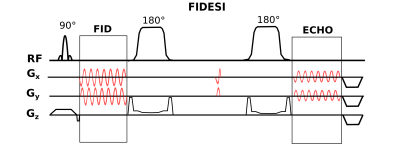 |
Whole Brain 3D-FIDESI-MRSI: Revisiting Free-Induction-Decay & Spin-Echo Readouts with Concentric Rings at 7 T
Lukas Hingerl1, Wolfgang Bogner1, Bernhard Strasser1, Petr Bednarik1, Stanislav Motyka1, Eva Heckova1, Ivica Just1, Alexandra Lipka1, Ovidiu Andronesi2, Stephan Gruber1, Siegfried Trattnig1,3, and Gilbert Hangel1,4
1Department of Biomedical Imaging and Image-guided Therapy, Medical University of Vienna, High Field MR Centre, Vienna, Austria, 2Department of Radiology, Massachusetts General Hospital, Martinos Center for Biomedical Imaging, Boston, MA, United States, 3Christian Doppler Laboratory for Clinical Molecular MR Imaging, Vienna, Austria, 4Department of Neurosurgery, Medical University of Vienna, Vienna, Austria
3D-FIDESI-MRSI combines a free-induction-decay-readout with an echo-readout to permit the measurement of whole-brain lactate as an important tumor biomarker in approximately 40 min. This enables the acquisition of signals at short TE with reduced T2-weighting as well as spectra at long TE without lipid contamination. Sufficient SNR is ensured by a smaller and oversampled spherical k-space coverage for the echo-readout using fast concentric ring trajectories. A test in a healthy volunteer successfully demonstrates feasible mapping of the major metabolites.
|
|||
 |
2209.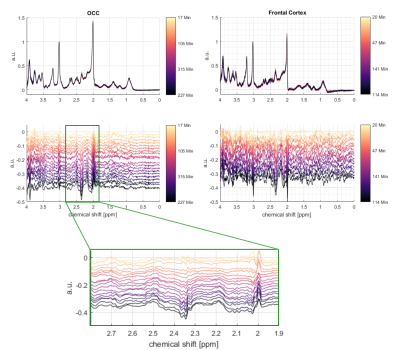 |
13C-Glucose Labeling Effects measured in the Occipital Lobe and the Frontal Cortex using short TE 1H MC-semiLASER SVS at 9.4T
Theresia Ziegs1,2, Johanna Dorst1,2, and Anke Henning1,3
1MRZ, MPI for Biological Cybernetics, Tuebingen, Germany, 2IMPRS for Cognitive and Systems Neuroscience, Tuebingen, Germany, 3Advanced Imaging Research Center, University of Texas Southwestern Medical Center, Dallas, TX, United States
Glutamate related metabolism can be measured considering the 13C labeling effects from an administered 13C labeled substrate by short TE 1H MRS spectra without the need for 13C channels, RF coils or scan software as required for direct 13C MRS or 13C edited 1H observed MRS. In this work, the labeling effects were followed in the frontal cortex and the occipital lobe using a short TE 1H MC-semiLASER sequence at 9.4T in healthy volunteers after oral intake of [13C-1]glucose. The spectral time series acquired show obvious 13C labelling related changes in the 1H observed Glu and Gln spectral pattern.
|
||
2210.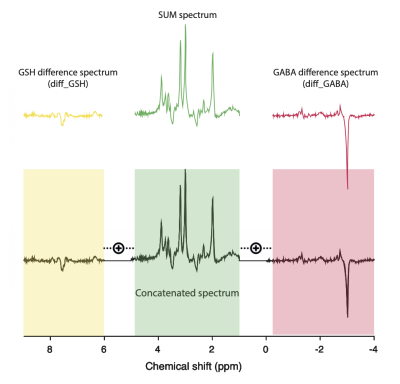 |
Repeatability assessment of GABA and GSH concentrations with HERMES: a comparison between traditional analysis and a novel approach
Diana Rotaru1, Georg Oeltzschner2,3, Richard Edden2,3, and David Lythgoe1
1Neuroimaging, King's College London, London, United Kingdom, 2Russell H. Morgan Department of Radiology and Radiological Science, The Johns Hopkins University School of Medicine, Baltimore, MD, United States, 3F. M. Kirby Research Center for Functional Brain Imaging, Kennedy Krieger Institute, Baltimore, MD, United States
Precise and accurate quantitation of GABA and GSH on 3T MR platforms is a great challenge in MR Spectroscopy. Despite this aspect, the reproducibility and repeatability of GABA and GSH measurements have been given little attention. In this study, test-retest repeatability was assessed for HERMES GABA and GSH estimates determined in LCModel using conventional single-spectrum analysis of Hadamard-reconstructed spectra (GABA difference, GSH difference and sum) and a novel analysis approach that models the Hadamard-reconstructed spectra simultaneously, hence using all spectral information acquired. The concatenated method allows simultaneous quantitation of GABA and GSH and provides comparable repeatability to traditional single-spectrum analysis.
|
|||
2211.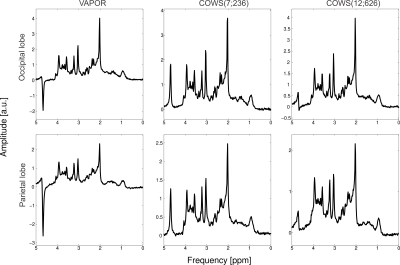 |
Constrained Optimized Water Suppression (COWS) for 1H Magnetic Resonance Spectroscopy
Karl Landheer1, Martin Gajdošík1, and Christoph Juchem1,2
1Biomedical Engineering, Columbia University, New York City, NY, United States, 2Radiology, Columbia University, New York City, NY, United States
Water suppression is a necessary component to magnetic resonance spectroscopy experiments due to its roughly 5000-fold higher intensity than the metabolites of interest. Here we introduce a novel algorithm for water suppression which operates in a similar manner to that originally proposed by WET and expanded upon by VAPOR, but is flexible in that it can accommodate an arbitrary number of RF pulses, minimum duration between pulses, total module duration and maximum flip angles. This method is referred to as Constrained Optimized Water Suppression. We demonstrated the improvement of COWS over the gold standard VAPOR in simulations and in vivo.
|
|||
2212.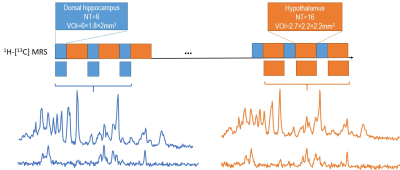 |
Feasibility of 1H-[13C] MRS of hippocampal and hypothalamic metabolism in the very same mouse with dynamic shim update (DSU)
Hikari Yoshihara1, Nicolas Kunz2, and Hongxia Lei2,3
1EPFL-LIFMET, Lausanne, Switzerland, 2EPFL-CIBM, Lausanne, Switzerland, 3United-Imaging Co. Ltd, Wuhan, China
13C MRS of the very same mouse hippocampus and hypothalamus at 14.1T is feasible using dynamic shimming update
|
|||
2213.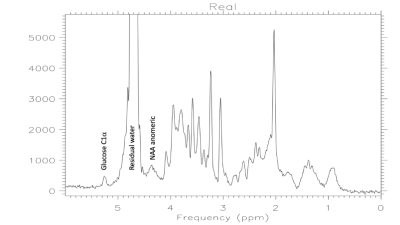 |
Utility of Residual Water in Proton MR Spectroscopy. The Measurement of Voxel Temperature and Hypoxia
Ralph E. Hurd1, Meng Gu1, Phil Adamson2, Kirk Riemer3, Ryan Beckman3, Michael Ma3, Kenichi Okamura3, Frank Hanley3, and Daniel Spielman1
1Radiology, Stanford, Stanford, CA, United States, 2Electrical Engineering, Stanford, Stanford, CA, United States, 3Cardiothoracic Surgery, Stanford, Stanford, CA, United States
The basic mantra for in vivo MR spectroscopy is to look beyond the dominant water and lipid signals. Although water is very well characterized by MRI, partially suppressed water can provide unique information in proton MR spectra. In the results presented, residual water-by-design strategy is demonstrated to extend beyond use as a reference. For the protocol described, water derived measurements of temperature and hypoxia, add critical value at no compromise.
|
|||
2214.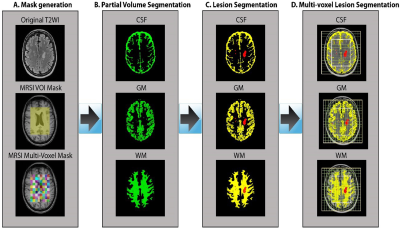 |
Mapping of differential metabolic regions of RRMS patients in multi-slices dimensional using Spiral-MRSI technique
Oun Al-iedani1,2, Jeannette Lechner-Scott2,3,4, Rodney Lea2, Ovidiu Andronesi5, and Saadallah Ramadan2,6
1School of Health Sciences, University of Newcastle, Newcastle, Australia, 2Hunter Medical Research Institute, Newcastle, Australia, 3Department of Neurology, John Hunter Hospital, Newcastle, Australia, 4School of Medicine and Public Health, University of Newcastle, Newcastle, Australia, 5Harvard Medical School, Massachusetts General Hospital, Boston, MA, United States, 6Faculty of Health and Medicine, University of Newcastle, Newcastle, Australia
The study designed a novel multi-dimensional metabolic mapping using multi-slice-spiral-MRSI with multi-voxel segmentation and differential metabolic regions(DMRs) techniques to demonstrate the true nature of NAWM and WM-lesions of RRMS patients,compared to HCs. 3D-spiral-MRSI covering majority of the brain in 16 RRMS and 13 HCs were used. Multi-slice-MRSI was processed using novel pipeline with DMRs classifications. Neurometabolic mapping of multi-DMRs revealed that(NAA/tCr) in WM-lesions was significantly lower than NAWM-MS and HCs,while (m-Ins/tCr) in WM-lesions were significantly higher than NAWM-MS and HCs. Multi-slice-spiral-MRSI coupled with DMRs may enhance a clinical monitoring of RRMS patients, and is sensitive in diagnosing NAWM in RRMS
|
|||
2215.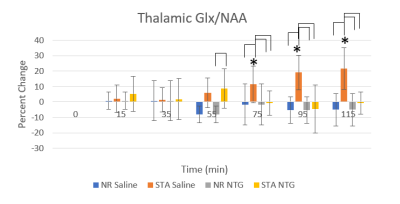 |
Metabolic Impact of Spontaneous Trigeminal Allodynia in Sprague-Dawley Rats: Implications for Migraine & other Neurological Disorders
Samuel W. Holder1,2, Michael Graham Harrington3, and Samuel Colles Grant1,2
1National High Magnetic Field Laboratory, Florida State University, Tallahassee, FL, United States, 2Chemical & Biomedical Engineering, FAMU-FSU College of Engineering, Tallahassee, FL, United States, 3Molecular Neurology Program, Huntington Medical Research Institutes, Pasadena, CA, United States
Spontaneous Trigeminal Allodynia (STA) occurs within ~50% of male Sprague-Dawley rats, presents symptoms analogous to migraine and may be alleviated by migraine treatments. Relaxation-enhanced MRS implemented in the female rat thalamus at 21.1 T examined metabolic effects of STA using a nitroglycerin-injected model of migraine. It was found that STA generates glutamate/glutamine and limited lactate responses with even saline injection. However, the STA response is rendered negligible when given a conventional dose of 10-mg/kg nitroglycerin. Future spectroscopic examinations of neurological disorders, particularly those focused on excitotoxicity/neuroprotection, should account for this potential effect.
|
|||
2216.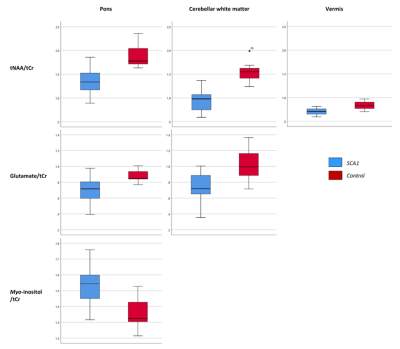 |
1H MRS biomarkers in spinocerebellar ataxia type 1
Kirsten Kapteijns1, Teije van Prooije1, Jack JA van Asten2, Bart van de Warrenburg1, and Tom WJ Scheenen2
1Dept of Neurology, Radboudumc, Nijmegen, Netherlands, 2Dept of Medical Imaging, Radboudumc, Nijmegen, Netherlands
Reliable biomarkers for SCA1 are necessary to reach trial-readiness. However, with small samples, it is important to interrogate the robustness of earlier biomarker findings. We performed single voxel 1H-MRS on 23 patients and 7 controls in the pons, cerebellar white matter, and vermis. Participants were evaluated on ataxia severity (SARA scale). Differences between groups showed alterations in tNAA, glutamate, and myo-Inositol. Negative correlations of tNAA with SARA could be found in all VOIs, and glutamate showed a negative correlation with SARA in the cerebellar WM. These findings are in line with earlier studies, and support the idea of MRS biomarkers.
|
|||
2217.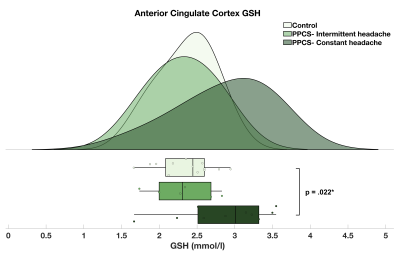 |
Examining the relationship between glutathione and post-traumatic headache in patients with persistent post-concussive symptoms
Julie M Joyce1,2,3,4, Leah J Mercier2,4,5, Parker L La1,2,3,4, Tiffany Bell1,2,3, Julia M Batycky2,4,5, Chantel T Debert2,3,4,5, and Ashley D Harris1,2,3,4
1Department of Radiology, University of Calgary, Calgary, AB, Canada, 2Hotchkiss Brain Institute, University of Calgary, Calgary, AB, Canada, 3Alberta Children's Hospital Research Institute, University of Calgary, Calgary, AB, Canada, 4Integrated Concussion Research Program, University of Calgary, Calgary, AB, Canada, 5Department of Clinical Neurosciences, University of Calgary, Calgary, AB, Canada
Persistent post-concussive symptoms (PPCS) are debilitating symptoms that endure beyond the usual recovery period after concussion. Post-traumatic headache is one of the most common symptoms of concussion and its pathophysiology remains poorly characterized. Oxidative stress may contribute to the symptoms seen in PPCS patients. Here, we use edited magnetic resonance spectroscopy to investigate levels of the antioxidant glutathione in the anterior cingulate and sensorimotor cortices in adults with PPCS relative to controls. In the anterior cingulate—a critical hub in the default mode network—we found a significant positive correlation between glutathione and functional impact of headache in PPCS patients.
|
|||
2218.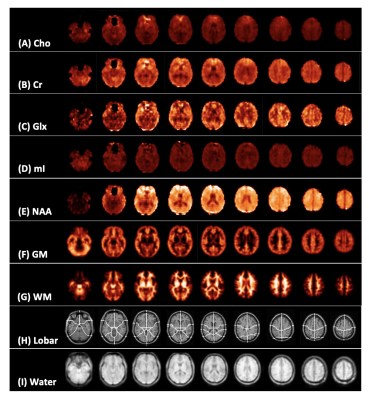 |
1H MR spectroscopic imaging for identifying diffuse abnormalities in mild traumatic brain injury: initial results from a reproducibility study
Anna M Chen1, Teresa Gerhalter1, Seena Dehkharghani1,2, Rosemary Peralta1, Fatemeh Adlparvar1, Martin Gajdošík3, Mickael Tordjman1,4, Julia Zabludovsky1, Sulaiman Sheriff5, James S Babb1, Tamara Bushnik6, Jonathan M Silver7, Brian S Im6,
Stephen P Wall8, Guillaume Madelin1, and Ivan I Kirov1,2,9
1Center for Biomedical Imaging, Department of Radiology, New York University Grossman School of Medicine, New York, NY, United States, 2Department of Neurology, New York University Grossman School of Medicine, New York, NY, United States, 3Department of Biomedical Engineering, Columbia University School of Engineering and Applied Science, New York, NY, United States, 4Department of Radiology, Cochin Hospital, Paris, France, 5Department of Radiology, University of Miami Miller School of Medicine, Miami, FL, United States, 6Department of Rehabilitation Medicine, New York University Grossman School of Medicine, New York, NY, United States, 7Department of Psychiatry, New York University Grossman School of Medicine, New York, NY, United States, 8Ronald O. Perelman Department of Emergency Medicine, New York University Grossman School of Medicine, New York, NY, United States, 9Center for Advanced Imaging Innovation and Research, Department of Radiology, New York University Grossman School of Medicine, New York, NY, United States
We present initial results from a reproducibility study of 1H MRSI in mild traumatic brain injury. In line with previous investigations in a separate cohort, linear regression analysis revealed white matter differences between patients and controls, which persisted when comparing only non-recovered patients to controls. In contrast to previous findings, however, the differences were not in N-acetyl aspartate (NAA), but in the glial markers creatine (Cr), choline (Cho), and myo-inositol (mI). Correlations were found between metabolites and neuropsychological testing in grey matter (GM), and between metabolites and symptomatology in white matter (WM).
|
The International Society for Magnetic Resonance in Medicine is accredited by the Accreditation Council for Continuing Medical Education to provide continuing medical education for physicians.